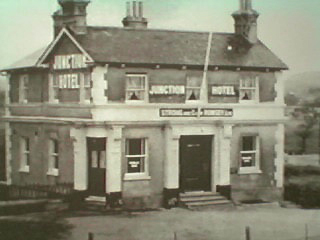

A little bit of history.
The railway arrived at Hamworthy in 1847, when the Southampton & Dorchester Railway company laid a `standard gauge' line from Southampton to Dorchester. The line went from Southampton via, Brockenhurst, Ringwood, Wimborne, Poole Junction (which is now named Hamworthy) continuing through Wareham to Dorchester. The section of line from Brockenhurst to Poole Junction was known as `Castleman's Corkscrew' due to the involvement of Mr Castleman (A prominent figure in Wimborne.) and the lines numerous curves. 1848 saw the London & South Western Railway take over working of the lines, A branch was laid to Lower Hamworthy and the first Poole Station was built on the shore of Poole Harbour.
In 1872 a branch line was built from Broadstone to Poole's second station (which is still known as Poole Station now) Poole Junction was renamed Hamworthy Junction. The line through Poole town was extended to reach Bournemouth West* in 1874 and again in 1888 to reach Bournemouth Central (Which is still known as Bournemouth Station)
Hamworthy Junction Station was completely rebuilt in 1892 when the route across Holes Bay from Hamworthy Junction to Poole was built, The Holes Bay route was opened to traffic in 1893 thus bypassing Castleman's Corkscrew, or `The Old Road' as it was known to the local railway employees giving a more direct route to Poole, and shortening the Waterloo - Hamworthy route mileage from 119.01 miles to 115.77 miles. Milepost 116 is situated on the Down Platform at the West end of the station.
The section of `The old road' from Hamworthy Junction to Broadstone was singled in 1932, Passenger services ceased on this section from Hamworthy in May 1964 with the line from Hamworthy to Broadstone being retained for goods use until 1966. the section from Hamworthy Junction towards Lytchett level crossing at Upton was used as storage sidings serving Hamworthy Junction station until complete removal of the sidings and associated pointwork and crossings in 1972.
NOTE: Bournemouth West* The site of Bournemouth West station is now partially redeveloped with the main road through Bournemouth splitting the site into two, Bournemouth Traincare Depot covering about half of the site, with the other half (across the main road) now being utilised as a coach park. Part of the embankment retaining wall survives on the South side of the site (in the coach park) with a large garage and residential buildings looking over it and one of the original bridges survives intact on the North side of the site and now carries the tracks that make up one end of the carriage wash loop.Hamworthy Junction Engine Shed.


The brick built engine shed at Hamworthy Junction was originally built in 1847 by the Southampton & Dorchester Railway as the Hamworthy Motive Power Depot, it later became a sub shed of Bournemouth. It is shown here looking South West (Date unknown) The run round loop can be seen with a coal wagon standing on it just to the left of the shed. The mainline to Weymouth is beyond the right of the picture, the line that still goes to what is now known as Hamworthy Goods is situated out of shot to the left, Hamworthy Junction Station is directly behind the photographer. The shed was closed in 1954 and demolished shortly afterwards.
The Junction Hotel, Hamworthy.

This image of the Junction Hotel (and the above images of Hamworthy Shed) are from old Postcards found by Colin Stone (A local railway historian & author of the excellent book `Rails to Poole Harbour') Unfortunately the Junction Hotel was demolished and the land was used for the building of a housing estate in the 1970's. The road in front of the hotel still follows part of its original course and is known as Junction Road, the road to the right of the hotel (running behind it to the left) was built for the new housing estate and is known as Turlin Road, it has now been extended for some way and is the main road running through the housing estate. The expanse of wild grassy moorland and marsh behind the Junction Hotel was originally named `Turling Moor' This area is now known as `Turlin Moor' and in January 2000 it is almost completely covered by the expanding housing estate, with a few shops, a Post Office, Two schools, A community centre, A sports center and playing fields. I am unsure of the actual date the name was changed, but I suspect it was when the new estate was built the `g' was dropped and over the years people have forgotten the areas proper original name. `Turling Moor'
The Waterloo - Weymouth main line running through Hamworthy Junction was the last All-Steam Mainline in the U.K. After which Diesel traction took over all workings through Hamworthy. The express London to Weymouth services were then hauled by Electric Multiple Units from Waterloo, the electrification terminated at Branksome near Bournemouth, bringing rise to most interesting "Push-Pull" workings with 4TC sets being detatched from the trains at Branksome, and hauled to Weymouth by Class 331xx Diesels fitted specifically for this service with push-pull control systems and a "rubbing plate" or "Push Plate" which contacts with a similar fitting on the end of the 4TC set (Push-Block & lower portion of the Gangway End connection) this allowed for the train to be propelled (Pushed) back from Weymouth to Branksome with the 331xx diesel controlled from the driving end cab of the 4TC set. The Push-Pull system was worked electrically through the existing coach lighting circuits, thus saving time and money converting coaches to other forms of push-pull train control tried in other regions. The Branksome to Weymouth section of the line was finally electrified in 1989, & most (maybe all? im not sure) of the 4TC push-pull sets were converted to EMU's running on the outside DC 3rd Rail system. Now (October 2000) The `modern' 5WES "Wessex Electric" multiple units dominate the passenger workings through Hamworthy.
